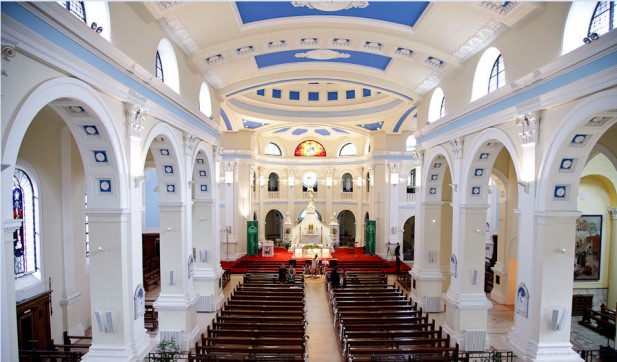Mags Gargan visits the National Shrine to St Anthony of Padua in Ireland
It’s just before the 11.30am Sunday novena Mass in the Church of the Immaculate Conception at the Friary of Adam and Eve on Merchant’s Quay in Dublin. A steady stream of devotees in their bright summer clothes are quietly queuing in the shade of this massive church to venerate the relic of St Anthony of Padua in Ireland’s national shrine.
Most are here for personal reasons or to pray for the intentions of others. Some tell me they are experiencing health issues, others are praying for students about to sit exams and one pilgrim was worried about being able to conceive a child. However, all of them are in agreement about the power of St Anthony’s intercession and they are just a small sample of the devotion to the saint in Ireland.
Every Franciscan church has a small relic of St Anthony. The Irish Franciscans (OFMs) first built a national shrine in 1912 in the church more commonly known as Adam and Eve’s. Following a fire in 1981 the shrine was redecorated and re-opened in 1983 by Archbishop Alibrandi, papal nuncio at the time.
Reminder
In the shrine there are 13 votive lamps burning as a reminder of the devotion of the 13 Tuesdays. (The practice of praying the 13 Tuesdays before the feast of St Anthony on June 13). The mosaic over the altar by G. Hajnal is based on the Risen Christ in glory. Four angels around the statue of St Anthony carry symbols associated with him: bread for the poor, a fish, a gospel book and lilies that are blessed on his feast day.
The six murals lining both walls are the work of Irish artist Muriel Brandt. They depict St Anthony’s miracles including the saint appearing to a Portuguese woman who was frequently threatened by the devil. On her way to drown herself she passed the friary church, realised that it was the feast of St Anthony, went to say a last prayer, fell into a trance and awoke to find a letter in her hand containing words of salvation. This is the origin of the devotion of St Anthony’s Brief (blessing).
The perpetual Novena in honour of St Anthony takes place in Adam and Eve’s every Tuesday with Mass at 12pm and 8pm and this is the busiest day of the week at the church. The saint’s connection with Tuesdays dates back to 1617, when he appeared to a pious lady of Bologna, Italy, who earnestly asked his help in an important matter and said to her: “Visit my statue in the Franciscan Church on nine consecutive Tuesdays and your prayer will be answered.”
She did so and to her great joy her request was granted. The fame of the miracle became widely known, and devotion to the Tuesdays spread through the world.
The annual novena in honour of St Anthony is currently underway in Adam and Eve’s and finishes on June 13. Novena Masses are at 12pm and 8pm except Sundays when Masses take place at 11.30am and 7.30pm.
Bro. Niall O’Connell, vicar at the friary, says this is “the most important event in our church”. “We are no longer a parish, because of the inner city parishes being merged, so our church is not that well attended normally. But for the novena the crowd just keeps building for the nine days until the feast day itself. There is a long tradition of people coming here for the feast, which is the only time we have a full church. It holds nearly 1,000 people and we have many people standing. It is a real tradition and every year you will meet people whose parents or grandparents came to Adam and Eve’s,” he says.
Tradition
Back in 2005 the Gerry Ryan Show on RTÉ 2FM held a vote among listeners for Ireland’s favourite saint. St Anthony of Padua topped the poll, just beating Padre Pio. Bro. Niall thinks it is tradition that is at the heart of the saint’s popularity.
“When I was growing up if you ever lost anything people would pray to St Anthony and you will find it. So he has always been a popular saint. It’s interesting that St Anthony himself wanted to lead a quiet life and it was by accident that he was asked to become a preacher. But once he started preaching he drew huge crowds so he had this intensity that people could relate easily to the Gospel that he was preaching. He always felt himself that it was God speaking through him, so he had a real ordinariness about his preaching. Even many of his miracle stories are very ordinary and human.”
Another less week-known Shrine to St Anthony exists in Dublin at the convent of the Religious Sisters of Charity beside Temple Street Children’s hospital. The hospital annals from 1894-1900 explain that the devotion of St Anthony’s bread was established there in 1895, “through the kind efforts of a Sister of Mercy who has great love for children”. With the permission of the Franciscan order the Association of St Anthony of Padua was established in the Children’s Hospital which had the aim of spreading devotion to St Anthony and giving bread to the poor.
The Anthonian Office at Temple Street remains the only centre in Ireland, England and Scotland where people can enrol in the Universal Association of St Anthony of Padua. Donations come from Ireland, England and many other parts of the world, accompanied by requests for the prayers of the sisters of the community for the intentions of the donors.
A constant stream of people from the area also comes to pray at the shrine, placing their intentions before St Anthony and making donations to St Anthony’s Fund for the Poor, according to Sr Naomi Coffey who worked at the shrine for six years until her health forced her to retire in 2014.
“The shrine used to be near the emergency department for the hospital,” Sr Naomi explains. “There was a most beautiful statue of St Anthony there and it was transferred to the new shrine at the convent when we left the hospital. People come in to the shrine all day long from 7am to 6pm, five days a week to pray. It seems to satisfy a deep spiritual need in people. There is a little box in the wall where they drop in their thanksgiving offerings. That money is collected at the end of the month and put into our fund for the poor. It’s still holding the same purpose as it did in the beginning.”
Sr Naomi says the devotion to St Anthony “is very strong and very much alive”. “We receive a lot of letters from across Ireland, England, Scotland even from the States and Australia. We also receive a lot of letters from the Travelling people, which are very moving,” she says.
“I didn’t really know St Anthony when I moved into the shrine in 2008, but I began to read up and it was extraordinary how the faith in his intercessory prayer grew so strong that it never left me. He was a very saintly, holy man who was out for aiding people and helping people. There is a real, natural, human element in that. You never hear of people being let down. He has an ear for people in need.”


 Mags Gargan
Mags Gargan Adam and Eve's Church, Merchants' Quay, Dublin. Photo credit: Franciscans
Adam and Eve's Church, Merchants' Quay, Dublin. Photo credit: Franciscans 